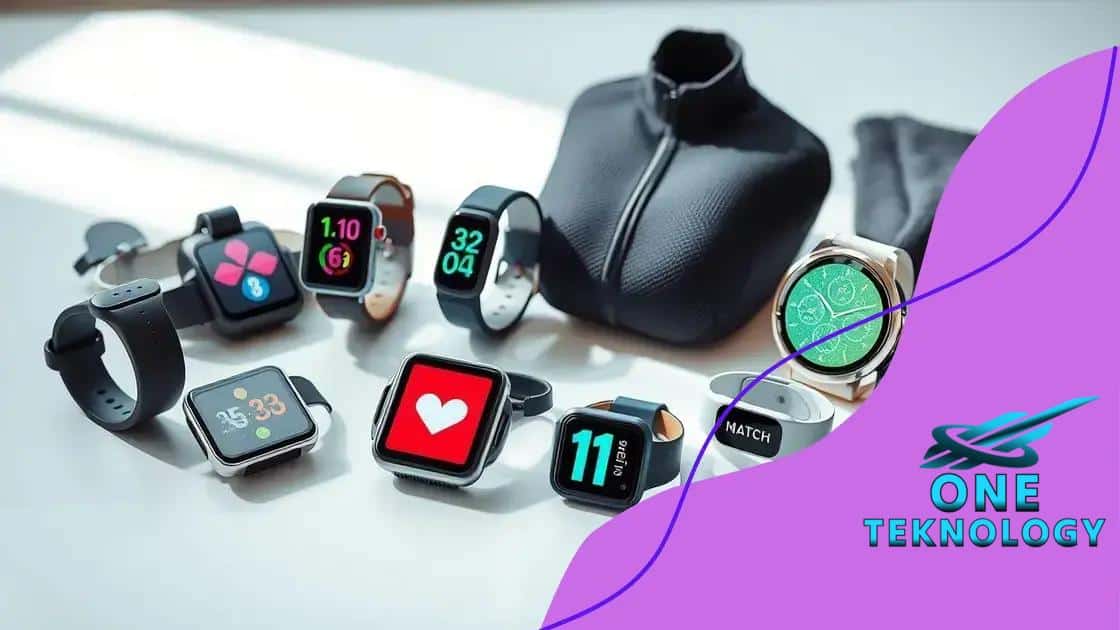The growth of wearable tech and its applications in healthcare

The growth of wearable tech and its applications in healthcare enhance personal health management by providing real-time monitoring, personalized insights, and improved communication between patients and healthcare providers.
The growth of wearable tech and its applications in healthcare is changing the way we think about health management. Imagine a world where your smartwatch alerts you to potential health issues before they escalate. Exciting, right?
Understanding wearable technology in healthcare
Understanding wearable technology in healthcare is key to embracing new advancements. These devices are not just trendy gadgets; they can play a vital role in monitoring health and wellness. As technology progresses, healthcare innovations like these become increasingly important for detecting health issues early.
What Are Wearable Devices?
Wearable devices refer to technology that can be worn on the body to collect data about a user’s health. Examples include smartwatches, fitness trackers, and even smart clothing. These devices gather significant amounts of data about the user’s activity level, heart rate, and more.
Benefits of Wearable Tech
- Real-time monitoring: Users can track their health metrics instantly.
- Increased awareness: Wearables encourage users to stay active and engaged with their health.
- Data for doctors: Physicians can access patient data effortlessly to make informed decisions.
As healthcare continues to evolve, the integration of these wearable technologies into medical practices shows great promise. For instance, devices equipped with sensors can alert users about potential health issues like heart irregularities.
Moreover, wearables empower patients by giving them control over their health data. They can set personal goals and track their progress, which can lead to healthier lifestyle choices. The information collected can not only serve individual needs but also assist healthcare professionals in providing better care.
Challenges Ahead
Despite the advantages, there are some challenges to consider. Privacy concerns are prevalent; users need assurance that their data remains secure. Additionally, the accuracy of the data collected by these devices can vary, raising questions about their reliability.
In conclusion, understanding wearable technology in healthcare is essential as it opens doors to innovative solutions for health management. As these tools become more widely accepted, the future of healthcare looks bright, providing more personalized and proactive care.
Key benefits of wearable devices for patients
Wearable devices offer numerous advantages for patients, transforming how they monitor their health and engage with their medical care. These technologies not only promote a healthier lifestyle but also enhance communication between patients and healthcare providers.
Enhanced Health Monitoring
One of the key benefits of wearable devices for patients is their ability to provide real-time health monitoring. Devices like smartwatches and fitness trackers allow users to monitor vital signs such as heart rate, blood pressure, and activity levels continuously. This provides invaluable data that can help detect potential health issues early.
Personalized Health Insights
Wearable tech can also deliver personalized health insights tailored to individual needs. By analyzing collected data, these devices can offer recommendations based on a user’s unique health patterns. This customization encourages patients to take a proactive approach to their wellbeing.
- Improved Engagement: Patients become more involved in their health journeys.
- Goal Setting: Users can set fitness goals and track their progress over time.
- Alerts and Notifications: Wearables can alert users about abnormal health readings.
The convenience of wearing these devices means that health tracking has never been easier. With just a glance at their wrist, patients can stay informed about their physical state and make necessary adjustments to their activities or medications.
Better Communication with Healthcare Providers
Another significant advantage is the enhanced communication between patients and their healthcare providers. Wearable devices can sync data to health apps that can be accessed by doctors. This allows for better-informed decisions during appointments and enables providers to guide their patients effectively.
In addition, this easy access to health data fosters trust and collaboration in the patient-doctor relationship. The transparency created by wearable technology enhances the overall quality of care patients receive.
Through the adoption of wearable devices, patients experience a more integrated approach to health management that is both empowering and supportive.
Popular wearable health tech products

Popular wearable health tech products offer innovative ways for individuals to track their health and fitness. From smartwatches to fitness bands, these devices make it easier than ever to monitor vital signs and activity levels.
Smartwatches
Smartwatches are among the most recognized wearable health devices on the market. Brands like Apple, Samsung, and Fitbit provide watches that not only tell time but also track heart rate, calories burned, and even sleep patterns. This multifunctionality helps users stay on top of their health goals.
Fitness Trackers
Fitness trackers are another popular category. These devices can be worn on the wrist and are designed to monitor physical activity throughout the day. They can measure steps, distance traveled, and other key metrics. Many users favor these trackers for their lightweight design and ease of use.
- Fitbit Charge: Known for its accuracy in monitoring activities and heart rates.
- Garmin Vivosmart: Offers advanced features for outdoor enthusiasts.
- Xiaomi Mi Band: Popular for its affordability and essential tracking functions.
Wearable health tech products often come with companion apps that provide deeper insights into collected data. By syncing with a smartphone, users can analyze trends in their health metrics over time. This connection can boost motivation and help individuals achieve their fitness aspirations.
Smart Clothing
Smart clothing is an emerging trend in wearable health technology. This category includes items like shirts and shorts with built-in sensors that monitor heart rate and other bodily functions. Companies are innovating to make these garments comfortable and effective, adding another layer of convenience for users.
With the growing variety of wearable health tech products available, individuals have more options than ever to find devices that suit their specific needs. Whether it’s a smartwatch for daily tracking or smart clothing for serious workouts, these innovations continue to enhance health monitoring.
Challenges and limitations of wearable healthcare tech
Challenges and limitations of wearable healthcare tech must be understood to appreciate its potential fully. While these devices offer numerous benefits, there are also hurdles that can hinder their effectiveness.
Data Privacy Concerns
One major challenge is data privacy. Wearable devices collect sensitive health information. Concerns arise regarding how this data is stored and who has access to it. Users often worry about their information being misused or shared without their consent, which can lead to distrust in technology.
Accuracy and Reliability
Accuracy is another limitation. Not all wearable devices provide precise readings. For critical health metrics, relying on devices that may misinterpret data can be risky. Variations in sensor technology and user factors can lead to discrepancies, impacting the reliability of information.
- Variability in Results: Different devices may yield different readings for the same measure.
- Calibration Issues: Some devices need regular recalibration to ensure accuracy.
- Hardware Limitations: Smaller sensors may lack the capability for detailed measurements.
Another significant issue is battery life. Many wearables require regular charging and might not last throughout the day, especially during extensive usage. This can lead to gaps in data and missed opportunities for health monitoring.
Adoption Barriers
Adoption barriers include the cost of high-quality devices and the need for technical knowledge to use them effectively. Not all consumers can afford expensive wearables, which can cause inequality in access to health technology. Additionally, older adults or those less tech-savvy may find it challenging to adapt to new devices.
Lastly, compliance is a persistent issue. Users may start strong but lose interest in wearing the devices over time. Without consistent usage, the full benefits of monitoring health data may not be realized.
The future of wearable health technology
The future of wearable health technology is exciting and full of potential. As advancements in technology continue, we can expect to see even more innovative devices that will enhance our health management.
Integration with AI
One major trend is the integration of artificial intelligence (AI) with wearable devices. AI can analyze vast amounts of data collected by these devices, providing deeper insights into health patterns and trends. This means healthcare providers can make better decisions based on accurate and timely information.
Enhanced Functionality
Future wearable devices are expected to offer enhanced functionality. For example, new sensors can monitor parameters not previously tracked, such as blood glucose levels or hydration status. This could be a game-changer for individuals managing chronic conditions.
- Real-time Diagnostics: Imagine a device that alerts users instantaneously about irregular health signs.
- Personalized Health Plans: Wearables might provide customized health plans based on ongoing data analysis.
- Interoperability: Future devices may work seamlessly across platforms, integrating with various health apps and systems.
In addition, the rise of telemedicine complements the growth of wearables. As virtual doctor visits become more common, having real-time data from wearables can enhance remote consultations and follow-ups, making healthcare more effective.
Greater Focus on Mental Health
Another aspect of the future is a greater focus on mental health. Wearables may include features to track stress levels or mood fluctuations, offering insights and recommendations for better mental health management. This holistic approach to health could bridge the gap between physical and mental well-being.
With these advancements, we are likely to see a connected ecosystem of wearable devices that work together to empower individuals in their health journeys. These innovations promise not only to enhance personal health management but also to change how healthcare is delivered and experienced.
FAQ – Frequently Asked Questions about Wearable Health Technology
What are wearable health devices?
Wearable health devices are gadgets like smartwatches and fitness trackers that monitor various health metrics, such as heart rate, activity level, and sleep patterns.
How do wearable devices benefit health management?
They provide real-time insights into health data, promote healthier lifestyle choices, and can alert users to potential health issues.
What challenges do wearable health technologies face?
Main challenges include data privacy concerns, accuracy of health readings, battery life, and the need for user compliance.
What does the future hold for wearable health tech?
The future includes AI integration for better data analysis, enhanced functionalities, and a greater focus on mental health features.






